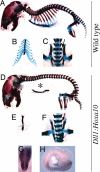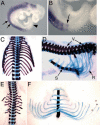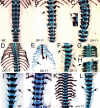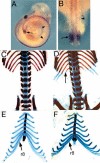Hox genes specify vertebral types in the presomitic mesoderm
- PMID: 16166377
- PMCID: PMC1221883
- DOI: 10.1101/gad.338705
Hox genes specify vertebral types in the presomitic mesoderm
Abstract
We show here that expression of Hoxa10 in the presomitic mesoderm is sufficient to confer a Hox group 10 patterning program to the somite, producing vertebrae without ribs, an effect not achieved when Hoxa10 is expressed in the somites. In addition, Hox group 11-dependent vertebral sacralization requires Hoxa11 expression in the presomitic mesoderm, while their caudal differentiation requires that Hoxa11 is expressed in the somites. Therefore, Hox gene patterning activity is different in the somites and presomitic mesoderm, the latter being very prominent for Hox gene-mediated patterning of the axial skeleton. This is further supported by our finding that inactivation of Gbx2, a homeobox-containing gene expressed in the presomitic mesoderm but not in the somites, produced Hox-like phenotypes in the axial skeleton without affecting Hox gene expression.
Figures



 indicates the position of vertebra 20, which is T13 in wild-type embryos; the
indicates the position of vertebra 20, which is T13 in wild-type embryos; the  indicates S1. (B,C) Ventral views of two Dll1-Hoxa11 transgenic embryos. In the embryo in B, S1 (
indicates S1. (B,C) Ventral views of two Dll1-Hoxa11 transgenic embryos. In the embryo in B, S1 ( ) is located in vertebra 24, and contains lateral protrusions in lumbar vertebrae (arrow). In the embryo in C, S1 is vertebra 26 and contains a lateral fusion between adjacent lumbar vertebrae (arrow in the blown-up region). (D) Thoracic area of a Dll1-Hoxa11 transgenic newborn showing fusions between the ossified area of adjacent ribs (arrows). (E) Sternum and the cartilaginous area of the ribcage of a Dll1-Hoxa11 transgenic newborn showing fusions between adjacent ribs (arrows). (F) Caudal region of a Dll1-Hoxa11 transgenic newborn showing fusions between adjacent vertebrae (arrows). (G,H) Cervical area of a wild-type (G) and a Dll1-Hoxa11 transgenic (H) newborn showing a lateral cartilaginous fusion between adjacent vertebrae (arrow in H). (I) Caudal area of a wild-type embryo. The arrow indicates the lateral process in a caudal vertebra. (J-L) The upper lumbar (J), thoracic (K), and sacral (L) areas of specific sm-Hoxa11 transgenic newborns. The arrow in J indicates an anteriorly projecting protuberance in a lumbar vertebra. The arrow in K indicates an anteriorly projecting protuberance at the base of a rib, and the arrowhead indicates an anteriorly projecting protuberance in a lumbar vertebra. The arrows in L show the unilateral anteriorization of the sacrum.
) is located in vertebra 24, and contains lateral protrusions in lumbar vertebrae (arrow). In the embryo in C, S1 is vertebra 26 and contains a lateral fusion between adjacent lumbar vertebrae (arrow in the blown-up region). (D) Thoracic area of a Dll1-Hoxa11 transgenic newborn showing fusions between the ossified area of adjacent ribs (arrows). (E) Sternum and the cartilaginous area of the ribcage of a Dll1-Hoxa11 transgenic newborn showing fusions between adjacent ribs (arrows). (F) Caudal region of a Dll1-Hoxa11 transgenic newborn showing fusions between adjacent vertebrae (arrows). (G,H) Cervical area of a wild-type (G) and a Dll1-Hoxa11 transgenic (H) newborn showing a lateral cartilaginous fusion between adjacent vertebrae (arrow in H). (I) Caudal area of a wild-type embryo. The arrow indicates the lateral process in a caudal vertebra. (J-L) The upper lumbar (J), thoracic (K), and sacral (L) areas of specific sm-Hoxa11 transgenic newborns. The arrow in J indicates an anteriorly projecting protuberance in a lumbar vertebra. The arrow in K indicates an anteriorly projecting protuberance at the base of a rib, and the arrowhead indicates an anteriorly projecting protuberance in a lumbar vertebra. The arrows in L show the unilateral anteriorization of the sacrum.
Similar articles
-
Compartmentalised expression of Delta-like 1 in epithelial somites is required for the formation of intervertebral joints.BMC Dev Biol. 2007 Jun 17;7:68. doi: 10.1186/1471-213X-7-68. BMC Dev Biol. 2007. PMID: 17572911 Free PMC article.
-
Plasticity of axial identity among somites: cranial somites can generate vertebrae without expressing Hox genes appropriate to the trunk.Dev Biol. 1999 Dec 15;216(2):507-20. doi: 10.1006/dbio.1999.9512. Dev Biol. 1999. PMID: 10642789
-
The road to the vertebral formula.Int J Dev Biol. 2009;53(8-10):1469-81. doi: 10.1387/ijdb.072276mm. Int J Dev Biol. 2009. PMID: 19247958 Review.
-
Control of the temporal and spatial Uncx4.1 expression in the paraxial mesoderm of avian embryos.Anat Embryol (Berl). 2004 Jul;208(4):323-32. doi: 10.1007/s00429-004-0404-3. Epub 2004 Jul 2. Anat Embryol (Berl). 2004. PMID: 15235909
-
The long and short of it: somite formation in mice.Dev Dyn. 2006 Sep;235(9):2330-6. doi: 10.1002/dvdy.20850. Dev Dyn. 2006. PMID: 16724326 Review.
Cited by
-
'Monster… -omics': on segmentation, re-segmentation, and vertebrae formation in amphibians and other vertebrates.Front Zool. 2013 Apr 11;10(1):17. doi: 10.1186/1742-9994-10-17. Front Zool. 2013. PMID: 23577917 Free PMC article.
-
Nr6a1 controls Hox expression dynamics and is a master regulator of vertebrate trunk development.Nat Commun. 2022 Dec 15;13(1):7766. doi: 10.1038/s41467-022-35303-4. Nat Commun. 2022. PMID: 36522318 Free PMC article.
-
What are the roles of retinoids, other morphogens, and Hox genes in setting up the vertebrate body axis?Genesis. 2019 Jul;57(7-8):e23296. doi: 10.1002/dvg.23296. Epub 2019 Apr 25. Genesis. 2019. PMID: 31021058 Free PMC article. Review.
-
VRTN is Required for the Development of Thoracic Vertebrae in Mammals.Int J Biol Sci. 2018 Apr 30;14(6):667-681. doi: 10.7150/ijbs.23815. eCollection 2018. Int J Biol Sci. 2018. PMID: 29904281 Free PMC article.
-
Homeotic transformations and number changes in the vertebral column of Triturus newts.PeerJ. 2015 Nov 10;3:e1397. doi: 10.7717/peerj.1397. eCollection 2015. PeerJ. 2015. PMID: 26587355 Free PMC article.
References
-
- Beckers J., Caron, A., Hrabe de Angelis, M., Hans, S., Campos-Ortega, J.A., and Gossler, A. 2000. Distinct regulatory elements direct δ1 expression in the nervous system and paraxial mesoderm of transgenic mice. Mech. Dev. 95: 23-34. - PubMed
-
- Bobola N., Carapuco, M., Ohnemus, S., Kanzler, B., Leibbrandt, A., Neubuser, A., Drouin, J., and Mallo, M. 2003. Mesenchymal patterning by Hoxa2 requires blocking Fgf-dependent activation of Ptx1. Development 130: 3403-3414. - PubMed
-
- Bouillet P., Chazaud, C., Oulad-Abdelghani, M., Dolle, P., and Chambon, P. 1995. Sequence and expression pattern of the Stra7 (Gbx-2) homeobox-containing gene induced by retinoic acid in P19 embryonal carcinoma cells. Dev. Dyn. 204: 372-382. - PubMed
-
- Burke A.C., Nelson, C.E., Morgan, B.A., and Tabin, C. 1995. Hox genes and the evolution of vertebrate axial morphology. Development 121: 333-346. - PubMed
-
- Chawengsaksophak K., James, R., Hammond, V.E., Kontgen, F., and Beck, F. 1997. Homeosis and intestinal tumours in Cdx2 mutant mice. Nature 386: 84-87. - PubMed
Publication types
MeSH terms
Substances
LinkOut - more resources
Full Text Sources
Molecular Biology Databases
Research Materials
